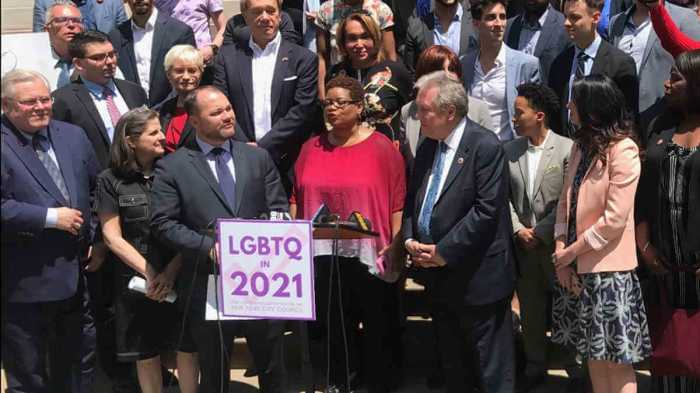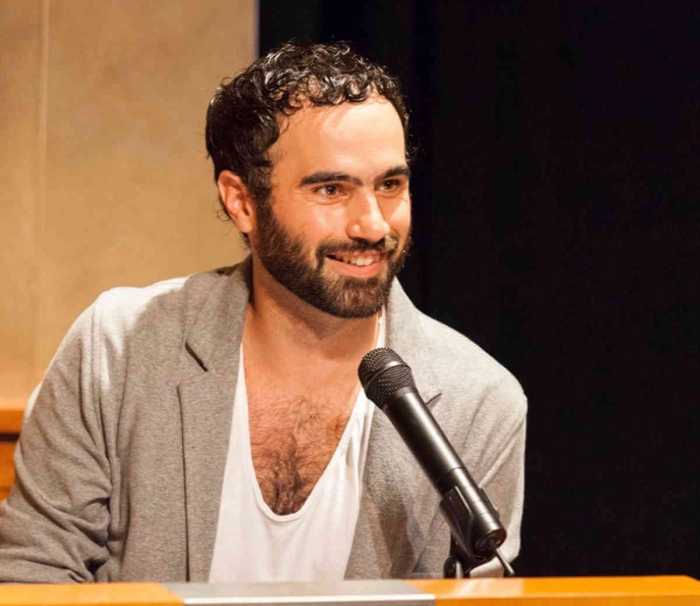The initial LGBT sites the National Parks Conservation Association proposed to consider for federal designation, a collection that tour participants were quick to supplement. | NATIONAL PARKS CONSERVATION ASSOCIATION
About 20 activists who have made some of their own LGBT history in New York took a walking tour through Greenwich Village on a chilly November 15 as part of a process of deciding what ought to be included in a federally designated site or area administered by the National Park Service.
The tour took in everything from the site of Pfaff’s on Broadway above Bleecker Street, where Walt Whitman hung out in the 1850s, to the Stonewall Inn, but also included other spots once (and sometimes still) home to gay restaurants, bars, and even cruising corners — many of which were subjected to police harassment over the years.
Also on the tour was the site of the apartment of a bisexual First Lady — not Chirlane McCray’s, but Eleanor Roosevelt’s pad at 29 Washington Square, where she once wrote, “I could see nice young men from my window,” as she gazed down on the gay male pick-up spot on the park’s western edge.
Under Obama administration initiative, Village venues scouted for federal designation opportunities
Tour participants included the state’s first out LGBT legislator, Assemblymember Deborah Glick, historian David Carter, who wrote a definitive account of the Stonewall Riots, Janet Weinberg, who formerly helmed Gay Men’s Health Crisis, gay civil liberties activist Bill Dobbs, transgender advocate Melissa Sklarz, gay archivist Rich Wandel and his fellow Gay Activists Alliance veteran Bill Bahlman, and Bill Hibsher, the board president at Congregation Beit Simchat Torah. Also on hand were a host of people from historic preservation groups and from philanthropy, including Andrew Lane, who heads the Johnson Family Foundation, and Ken Lustbader, director of Historic Preservation at the JM Kaplan Fund.
The tour was organized by the National Parks Conservation Association (NPCA), the largest advocacy group for US parks, which wants to take advantage of new interest on the part of the National Park Service in LGBT history. There is a closing window of opportunity to get federal designations for significant LGBT sites or districts under President Barack Obama’s power to declare national monuments. Interest has also been stoked by the upcoming 50th anniversary of the Stonewall Riots in 2019.
Cortney Worrall, senior regional director of the NPCA’s Northeast Regional Office, said that what gets designated is “up to the community. We need to build community support for Stonewall or some component of Stonewall and other sites within Greenwich Village becoming designated in a better way by the Park Service.” And she said that while Stonewall is key to telling “the overall story” of the LGBT movement, “we’re learning that the story starts in the middle of the 19th century.”
Worrall explained, “We’re not talking about taking over or preserving these sites. It could be something as simple as a trail like the Freedom Trail [of Revolutionary era history] in Boston or a visitor center in Greenwich Village with a place to have archives.”
The November 15 tour and a meeting afterwards was one of a series of consultations NPCA is conducting, an effort that will continue with a Harlem gathering soon and later perhaps in other parts of the city.
While the map distributed for the tour included two dozen notable places where LGBT history was made, tour guide Jay Shockley of the city’s Landmarks Preservation Commission added more as did many of the participants, particularly highlighting more lesbian sites and more places where LGBT political action took places on the streets of Greenwich Village. There was also discussion of seeking out more sites relevant to the transgender struggle for visibility and equal treatment.
“We don’t want people to think this is a done deal,” Worrall explained. “It is in its earliest stages and we want ideas. We have the tools to make this happen in Washington.”
She invited those from the public with ideas to email her at cworrall@npca.org.
“It was a great thing,” said Wandel, the founder of the LGBT Community Center’s National History Archive. “But it is going to take a while. It depends upon the federal government owning some property to tag it to. One possibility discussed was the city transferring Christopher Park,” which lies across the street from the Stonewall, to the feds.
“Everyone is aware of Stonewall internationally,” said Glick, who mentioned other locations outside of the Village such as in Harlem and the Firehouse at 99 Wooster St. in Soho, which served as the gay and lesbian movement’s headquarters and community center for several years post-Stonewall before it was lost to a fire.
Weinberg said, “There’s also a lot of lesbian history in the Village,” citing bars such as Bonnie & Clyde’s and the Duchess, which was just south of Sheridan Square and closed by the State Liquor Authority for not serving men in the early 1980s, an action followed by massive, but unavailing street protests. Weinberg would also like to see the New York chapter of the lesbian group Daughters of Bilitis, founded in the 1950s, recognized.
Dobbs observed, “It’s an interesting moment where we’re seeing a push for federal recognition of sexual minority struggles, but at the same time the movement is so respectable that it is no longer a threat to the status quo.”
While the NPCA has been the impetus behind this push, Bahlman, a veteran organizer, hopes community members will coalesce into some kind of ad hoc advocacy group as well. While there was some talk of getting a wealthy donor to buy the Stonewall and turn it into an historic site, Bahlman said that it had been “a pretty horrible bar” when it was raided and care should be taken not to restore it as some kind of “house of horrors.”



































